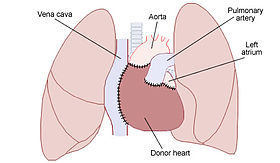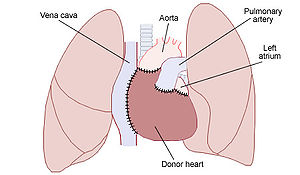Heart transplantation
This article needs additional citations for verification. (November 2011) |
| Heart transplantation | |
|---|---|
 Diagram illustrating the placement of a donor heart in an orthotopic procedure. Notice how the back of the patient's left atrium and great vessels are left in place. | |
| Specialty | cardiology |
| ICD-9-CM | 37.51 |
| MeSH | D016027 |
A heart transplant, or a cardiac transplantation, is a surgical transplant procedure performed on patients with end-stage heart failure or severe coronary artery disease. As of 2008 the most common procedure was to take a working heart from a recently deceased organ donor (cadaveric allograft) and implant it into the patient. The patient's own heart is either removed (orthotopic procedure) or, less commonly, left in place to support the donor heart (heterotopic procedure); both were controversial solutions to an enduring human ailment. Post-operation survival periods averaged 15 years.[1]
The world's first human heart transplant was performed in 1967 by Christiaan Barnard on Louis Washkansky at the Groote Schuur Hospital in Cape Town South Africa.[2] Worldwide, about 3,500 heart transplants were performed annually as of 2007; about 800,000 people had a Class IV heart defect indicating a new organ.[3] This disparity spurred research into the transplantation of non-human hearts into humans after 1993. Xenografts from other species and man-made artificial hearts are two less successful alternatives to allografts.[1] In 2011, Cedars-Sinai Medical Center in Los Angeles, CA. was recognized for performing the most heart transplantations of any U.S. medical center for 2010. The hospital had completed 652 procedures since the program's inception in 1988.[4]

Contraindications
Some patients are less suitable for a heart transplant, especially if they suffer from other circulatory conditions unrelated to the heart. The following conditions in a patient increase the chances of complications:
- Kidney, lung, or liver disease
- Insulin-dependent diabetes with other organ dysfunction
- Life-threatening diseases unrelated to heart failure
- Vascular disease of the neck and leg arteries.
- High pulmonary vascular resistance
- Recent thromboembolism
- Age over 60 years (some variation between centers)
- Substance abuse (which increases the chance of lung disease)
Procedures
Pre-operative
A typical heart transplantation begins when a suitable donor heart is identified. The heart comes from a recently deceased or brain dead donor, also called a beating heart cadaver. The patient is contacted by a nurse coordinator and instructed to come to the hospital for evaluation and pre-surgical medication. At the same time, the heart is removed from the donor and inspected by a team of surgeons to see if it is in suitable condition. Learning that a potential organ is unsuitable can induce distress in an already fragile patient, who usually requires emotional support before returning home.
The patient must also undergo emotional, psychological, and physical tests to verify mental health and ability to make good use of a new heart. The patient is also given immunosuppressant medication so that their immune system does not reject the new heart.
Operative

Once the donor heart passes inspection, the patient is taken into the operating room and given a general anaesthetic. Either an orthotopic or a heterotopic procedure follows, depending on the conditions of the patient and the donor heart.
Orthotopic procedure
The orthotopic procedure begins with a median sternotomy, opening the chest and exposing the mediastinum. The pericardium is opened, the great vessels are dissected and the patient is attached to cardiopulmonary bypass. The donor's heart is injected with potassium chloride. KCl stops the heartbeat before the heart is removed from the donor's body and packed in ice. Ice can usually keep the heart usable four[5] to six hours depending on preservation and starting condition. The failing heart is removed by transecting the great vessels and a portion of the left atrium. The patient's pulmonary veins are not transected; rather a circular portion of the left atrium containing the pulmonary veins is left in place. The donor heart is trimmed to fit onto the patient's remaining left atrium and the great vessels are sutured in place. The new heart is restarted, the patient is weaned from cardiopulmonary bypass and the chest cavity is closed.
Heterotopic procedure
In the heterotopic procedure, the patient's own heart is not removed. The new heart is positioned so that the chambers and blood vessels of both hearts can be connected to form what is effectively a 'double heart'. The procedure can give the patient's original heart a chance to recover, and if the donor's heart fails (e.g., through rejection), it can later be removed, leaving the patient's original heart. Heterotopic procedures are used only in cases where the donor heart is not strong enough to function by itself (because either the patient's body is considerably larger than the donor's, the donor's heart is itself weak, or the patient suffers from pulmonary hypertension).
'Living organ' transplant
In February 2006, at the Bad Oeynhausen Clinic for Thorax and Cardiovascular Surgery, Germany, surgeons successfully transplanted a 'beating heart' into a patient.[6] Rather than cooling the heart, the living organ procedure keeps it at body temperature and connects it to a special machine called an Organ Care System that allows it to continue pumping warm, oxygenated blood. This technique can maintain the heart in a suitable condition for much longer than the traditional method.
Post-operative

The patient is taken to the ICU to recover. When they wake up, they move to a special recovery unit for rehabilitation. The duration of in-hospital, post-transplant care depends on the patient's general health, how well the heart is working, and the patient's ability to look after the new heart. Doctors typically prefer that patients leave the hospital 1 – 2 weeks after surgery, because of the risk of infection and presuming no complications. After release, the patient returns for regular check-ups and rehabilitation. They may also require emotional support. The frequency of hospital visits decreases as the patient adjusts to the transplant. The patient remains on immunosuppressant medication to avoid the possibility of rejection. Since the vagus nerve is severed during the operation, the new heart beats at around 100 beats per minute unless nerve regrowth occurs.
The patient is regularly monitored to detect rejection. This surveillance can be performed via frequent biopsy or a gene expression blood test known as AlloMap Molecular Expression Testing. Typically, biopsy is performed immediately post-transplant and then AlloMap replaces it once the patient is stable. The transition from biopsy to AlloMap can occur as soon as 55 days after the transplant.
Complications
Post-operative complications include infection, sepsis, organ rejection, as well as the side-effects of the immunosupressive medication. Since the transplanted heart originates from another organism, the recipient's immune system typically attempts to reject it. Immunosupressive drugs reduce that risk, but may cause unwanted side effects, such as increased likelihood of infections or nephrotoxic effects. Many recent advances in reducing complications due to tissue rejection stem from mouse heart transplant procedures.[7]
Prognosis
The prognosis for heart transplant patients following the orthotopic procedure has increased over the past 20 years, and as of June 5, 2009, the survival rates were:[8]
- 1 year : 88.0% (males), 86.2% (females)
- 3 years: 79.3% (males), 77.2% (females)
- 5 years: 73.1% (males), 69.0% (females)
In a November 2008 study conducted on behalf of the U.S. federal government by Dr. Eric Weiss of the Johns Hopkins University School of Medicine, it was discovered that heart transplants — other factors equal — work better in male to male and female to female transplants. However, due to the scarcity of donors, this is not always feasible.[citation needed]
Notable recipients
At the time of his death on August 10, 2009, Tony Huesman was the world's longest living heart transplant recipient, having survived for 31 years. Huesman received a heart in 1978 at the age of 20 after viral pneumonia severely weakened his heart. Huesman died of cancer.[9] The operation was performed at Stanford University under heart transplant pioneer Dr. Norman Shumway.[10]
Kelly Perkins climbs mountains around the world to promote positive awareness of organ donation. Perkins was the first recipient to climb the peaks of Mt. Fuji, Mt. Kilimanjaro, the Matterhorn, Mt. Whitney, and Cajon de Arenales in Argentina in 2007, 12 years after her surgery.[citation needed]
Twenty-two years after Dwight Kroening's heart transplant, he was the first recipient to finish an Ironman competition.[11]
Fiona Coote was the second Australian to receive a heart transplant in 1984 (at age 14) and the youngest Australian. In the 24 years after her transplant she became involved in publicity and charity work for the Red Cross, and promoted organ donation in Australia.[citation needed]
Race car driver and manufacturer Carroll Shelby received a heart transplant in 1990[12].
Golfer Erik Compton qualified for the PGA Tour at age 32, after his second heart transplant.[13]
Former Vice President of the United States Dick Cheney received a heart transplant on March 24, 2012. [14]
Economic aspect
Typical expenses during the first year (everything including surgery, hospitalization, lab testing, medications) averaged $787,700 in 2008.[15][16]
See also
References
- ^ a b Till Lehmann (director) (2007). The Heart-Makers: The Future of Transplant Medicine (documentary film). Germany: LOOKS film and television.
- ^ "Memories of the Heart". Doylestown, Pennsylvania: Daily Intelligencer. November 29, 1987. p. A–18.
{{cite news}}: Italic or bold markup not allowed in:|publisher=(help) - ^ Reiner Körfer (interviewee) (2007). The Heart-Makers: The Future of Transplant Medicine (documentary film). Germany: LOOKS film and television.
- ^ "Cedars-Sinai Heart Institute Ranked First Nationally in 2010 Adult Heart Transplants". March 9, 2011. Retrieved November 18, 2011.
- ^ Custodiol Htk Solution patient advice including side effects
- ^ "Bad Oeynhausen Clinic for Thorax- and Cardiovascular Surgery Announces First Successful Beating Human Heart Transplant". TransMedics. 23 February 2006. Retrieved 2007-05-14.
- ^ Bishay, R. The ‘ Mighty Mouse’ Model in Experimental Cardiac Transplantation. Hypothesis 2011, 9(1): e5.
- ^ Heart Transplants: Statistics The American Heart Association. Retrieved 25 June 2011.
- ^ http://www.columbusdispatch.com/live/content/local_news/stories/2009/08/10/aheart.html?sid=101
- ^ Heart Transplant Patient OK After 28 Yrs (14 September 2006) CBS News. Retrieved 29 December 2006.
- ^ Dwight Kroening first heart transplant to do ironman Retrieved 27 August 2008.
- ^ http://articles.latimes.com/1996-01-31/sports/sp-30636_1_heart-transplant
- ^ [1]
- ^ [2]
- ^ http://publications.milliman.com/research/health-rr/pdfs/2008-us-organ-tisse-RR4-1-08.pdf 2008 U.S. organ and tissue transplant cost estimates and discussion
- ^ http://www.transplantliving.org/beforethetransplant/finance/costs.aspx Financing a Transplant
External links
- Orthotopic Heart Transplant Video
- Official Heart Transplant Museum - Heart Of Cape Town
- Photograph of first U.S. heart transplant
- Western Cape government, South Africa (21 February 2005). "Chris Barnard Performs World's First Heart Transplant". Cape Gateway. Retrieved 2007-01-10.
- Department of Cardiothoracic Surgery. "Patient's Guide to Heart Transplant Surgery". University of Southern California. Retrieved 2007-01-10.
- Nancy Reid (22 September 2005). "Heart transplant: How is it performed?". Healthwise. Retrieved 2007-01-10.
- Jeffrey Everett (2003-10-29). "Heart Transplant: Indications". AllRefer.com. Retrieved 2007-01-10.
